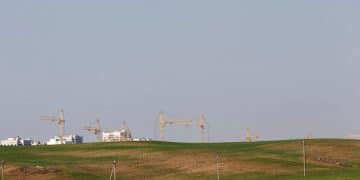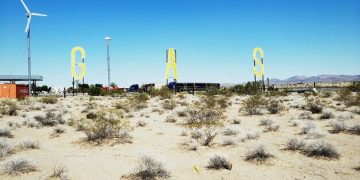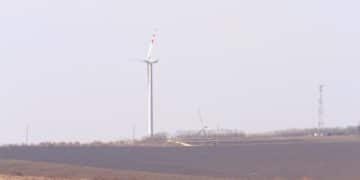Extreme Weather’s Impact: Securing US Energy Infrastructure
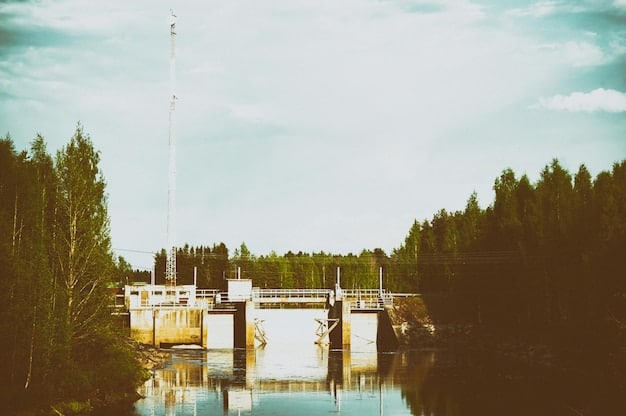
The increasing frequency of extreme weather events poses significant threats to the U.S. energy infrastructure, potentially disrupting power generation, transmission, and distribution, requiring urgent resilience measures.
The escalating frequency of extreme weather events is a growing concern, particularly when considering its impact on the U.S. energy infrastructure. Assessing how will the increasing frequency of extreme weather events impact US energy infrastructure? it is crucial for ensuring a reliable and resilient energy supply for the nation.
Understanding the Vulnerabilities of US Energy Infrastructure
The U.S. energy infrastructure, encompassing power plants, transmission lines, and distribution networks, faces mounting challenges from extreme weather. Understanding these vulnerabilities is the first step toward building a more resilient system.
Power Plants at Risk
Power plants, especially those located near coastlines or major waterways, are susceptible to flooding, storm surges, and extreme temperatures. These events can damage critical equipment and disrupt operations.
Transmission Line Weaknesses
Transmission lines, which carry electricity over long distances, are vulnerable to high winds, ice storms, and wildfires. Damage to these lines can result in widespread power outages.
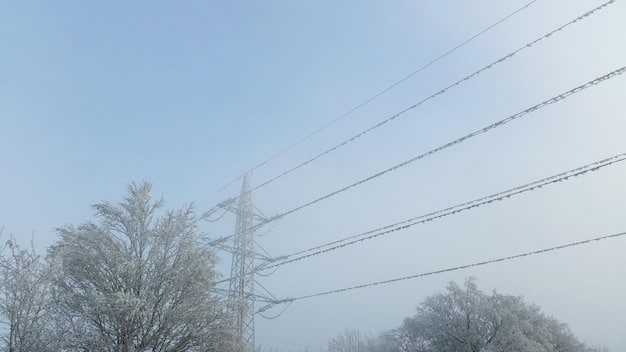
To better understand these challenges, consider the following points:
- Geographic Location: Power plants and infrastructure located in coastal areas or floodplains are at higher risk.
- Age of Infrastructure: Older infrastructure may not be designed to withstand modern extreme weather events.
- Interdependencies: The energy infrastructure is interconnected, meaning a failure in one part can cascade through the system.
In conclusion, the vulnerabilities of U.S. energy infrastructure are multifaceted, encompassing power generation, transmission, and distribution, each requiring specific adaptation strategies.
The Impact of Hurricanes and Coastal Storms
Hurricanes and coastal storms pose a significant threat to energy infrastructure due to high winds, storm surges, and flooding. These events can cause extensive damage and prolonged power outages.
Damage from High Winds
High winds associated with hurricanes can topple transmission towers and damage power plants, leading to widespread electricity disruptions.
The Threat of Storm Surges
Storm surges can flood coastal power plants and substations, causing significant damage to equipment and interrupting operations.
Several examples highlight the devastating impact of these storms:
- Hurricane Katrina: In 2005, Hurricane Katrina caused widespread damage to energy infrastructure along the Gulf Coast, resulting in prolonged power outages.
- Superstorm Sandy: In 2012, Superstorm Sandy flooded substations and power plants in New York and New Jersey, leaving millions without power.
- Hurricane Maria: In 2017, Hurricane Maria devastated Puerto Rico’s energy infrastructure, causing a near-total collapse of the power grid.
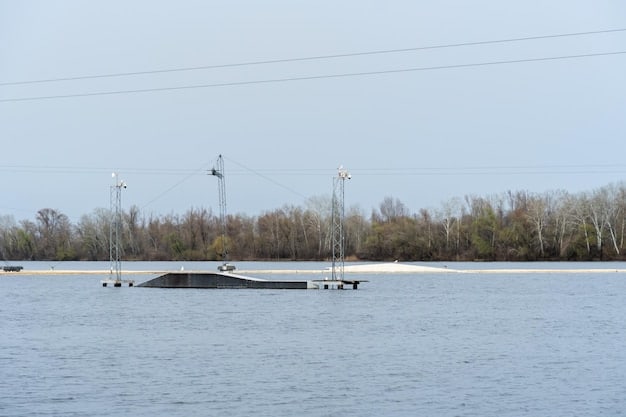
In sum, hurricanes and coastal storms present an ongoing threat to U.S. energy infrastructure, necessitating robust preparedness and resilience measures to minimize disruptions and ensure rapid recovery.
The Role of Extreme Temperatures and Droughts
Extreme temperatures and droughts can strain energy infrastructure, leading to reduced power generation and increased demand. These conditions can exacerbate existing vulnerabilities and contribute to energy shortages.
Heat Waves and Energy Demand
Heat waves drive up demand for electricity as people use air conditioning to stay cool. This increased demand can strain power grids and lead to blackouts.
Droughts Affecting Hydropower and Cooling
Droughts reduce water levels in rivers and reservoirs, impacting hydropower generation and the availability of cooling water for thermal power plants.
The correlation between extreme temperatures, droughts, and energy infrastructure performance is crucial:
- Reduced Power Generation: Droughts can curtail hydroelectric power, while high temperatures can lower the efficiency of thermal plants.
- Increased Demand: As temperatures rise, the demand for electricity for cooling increases, pushing grids to their limits.
- Operational Challenges: Power plants may need to reduce output or shut down entirely if cooling water is scarce or too warm.
In summary, extreme temperatures and droughts pose significant challenges to U.S. energy infrastructure, highlighting the need for diversified energy sources and improved water management strategies.
Wildfires and Their Effects on Power Grids
Wildfires are an increasing threat to energy infrastructure, particularly in the western United States. These fires can damage transmission lines, substations, and power plants, leading to widespread power outages and economic losses.
Transmission Line Damage
Wildfires can directly damage transmission lines, causing them to fall and disrupt electricity flow. Smoke and soot can also reduce the efficiency of solar power plants.
Vegetation Management
Inadequate vegetation management around power lines can exacerbate the risk of wildfires. Overgrown vegetation can come into contact with power lines, sparking fires.
Mitigating the threat of wildfires to energy infrastructure includes a combination of strategies:
- Enhanced Vegetation Management: Regularly clearing vegetation around power lines to reduce the risk of fire ignition.
- Fire-Resistant Infrastructure: Using fire-resistant materials in the construction of transmission towers and substations.
- Advanced Monitoring Systems: Implementing real-time monitoring systems to detect and respond to wildfires quickly.
In short, wildfires pose significant threats to U.S. power grids, requiring proactive management and investment in resilient infrastructure to minimize disruptions and protect communities.
Adaptation Strategies for a Resilient Energy Future
To mitigate the impacts of extreme weather on energy infrastructure, a range of adaptation strategies are needed. These strategies include infrastructure hardening, diversification of energy sources, and improved grid management.
Infrastructure Hardening
Infrastructure hardening involves strengthening existing energy infrastructure to withstand extreme weather events. This can include upgrading transmission towers, protecting power plants from flooding, and burying power lines underground.
Diversification of Energy Sources
Diversifying energy sources can reduce reliance on any single fuel source and make the energy system more resilient. This can include increasing the use of renewable energy sources such as solar, wind, and geothermal.
The key elements of building a resilient energy system are:
- Upgrading Infrastructure: Strengthening grids, protecting power plants, and using resilient materials.
- Diversifying Energy Sources: Incorporating more renewables and distributed generation.
- Improving Grid Management: Using smart grid technologies for better monitoring and control.
In conclusion, adaptation strategies are essential for ensuring a resilient energy future in the face of increasing extreme weather events.
Policy and Investment Needs for Energy Resilience
Addressing the challenges posed by extreme weather requires supportive policies and significant investment in energy resilience. Government policies can incentivize infrastructure upgrades, promote renewable energy, and encourage smart grid technologies.
Government Incentives
Government incentives, such as tax credits and grants, can encourage utilities to invest in infrastructure hardening and renewable energy projects.
Regulatory Reforms
Regulatory reforms can streamline the approval process for energy projects and ensure that energy infrastructure is built to withstand extreme weather events.
Several key actions are necessary to prioritize energy resilience at the policy level:
- Increase Energy Storage: Implement better methods of storing excess energy.
- Federal disaster funding: Provide more funding in areas that are affected by extreme weather events.
In summary, supportive policies and strategic investment are essential for building a more resilient energy system that can withstand the growing threat of extreme weather.
| Key Point | Brief Description |
|---|---|
| 🌊 Coastal Storm Risks | Hurricanes and storm surges damage coastal power plants and infrastructure. |
| 🔥 Wildfire Threats | Wildfires can destroy transmission lines and disrupt power grids. |
| 🌡️ Extreme Temperatures | Heat waves and droughts strain energy infrastructure and reduce power generation. |
| 🌱 Adaptation Strategies | Infrastructure hardening, diversification, and improved grid management are key. |
FAQ
▼
The main threats include damage from hurricanes, wildfires, extreme temperatures, and droughts, all of which can disrupt power generation, transmission, and distribution.
▼
Infrastructure hardening involves upgrading transmission towers, protecting power plants from flooding, and burying power lines to withstand severe weather conditions more effectively.
▼
Diversifying energy sources reduces reliance on any single fuel, making the energy system more resilient to disruptions caused by extreme weather events and other factors.
▼
Government policies can incentivize infrastructure upgrades, promote renewable energy adoption, and encourage the use of smart grid technologies to enhance energy resilience.
▼
Wildfires can directly damage transmission lines and substations, leading to widespread power outages, and can also reduce the efficiency of solar power plants due to smoke and soot.
Conclusion
In conclusion, the increasing frequency of extreme weather events poses significant threats to U.S. energy infrastructure, necessitating comprehensive adaptation strategies, supportive policies, and strategic investments to ensure a resilient and reliable energy future.
